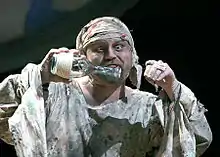假想朋友
假想朋友(英文:Imaginary friend)也稱為假裝朋友、隱形朋友或虛構朋友,是一種心理和社會現象,其友誼或其他人際關係發生在想像中,而不是外部物理的現實世界中。儘管對於創作者來說,他們看起來很真實,但是孩子們通常都知道,他們的想像中的朋友不是真實的。[1]據信,最初針對假想朋友的研究是在1890年代進行的。[2]對於兒童假想朋友的出現和成長相關的訊息很少。然而,克勞森和帕斯曼(Klausen and Passman(2007))報告說,假想的朋友最初被描述為超自然的生物和靈魂,被認為可以將人們與他們的前世聯繫起來。[3]歷史早期的成年人擁有家庭神和守護天使之類的實體,還有充當虛構伴侶的繆斯女神,為創作工作提供舒適,指導和靈感。[3]最終,想像中的同伴現像傳給了孩子們。兒童開始與虛構的朋友交往的時代是未知的,但這種現像有可能出現在19世紀中葉,當時人們強調將童年作為遊戲和想像的重要時間。[3]

Caliban has a conversation with his imaginary friends in Folger Theatre's production of Shakespeare's The Tempest.
參考資料
- Taylor, M. (1999) Imaginary Companions and the Children Who Create Them. New York: Oxford University Press.
- Klausen, Espen; Richard H. Passman. . Journal of Genetic Psychology. December 2006, 167 (4): 349–364 [9 November 2011]. PMID 17645227. doi:10.3200/gntp.167.4.349-364. Gale Document Number: GALE|A166239640.
- Klausen, E.; Passman, R. H. . The Journal of Genetic Psychology. 2007, 167 (4): 349–364. PMID 17645227. doi:10.3200/gntp.167.4.349-364.
延伸閱讀
- Dierker, L. C.; Davis, K. F.; Sanders, B. . Dissociation. 1995, 8: 220–228.
- Gleason, T. . Developmental Psychology. 2002, 38 (6): 979–992. PMID 12428709. doi:10.1037/0012-1649.38.6.979.
- Gleason, T. (2009). 'Imaginary companions.' In Harry T. Reis & Susan Sprecher (Eds.), Encyclopedia of Human Relationships (pp. 833–834). Thousand Oaks, CA: Sage.
- Hall, E. (1982). 'The fearful child's hidden talents [Interview with Jerome Kagan].' Psychology Today, 16 (July), 50–59.
- Hurlock, E.; Burstein, M. . Journal of Genetic Psychology. 1932, 41 (2): 380–392. doi:10.1080/08856559.1932.10533102.
- Manosevitz, M.; Fling, S.; Prentice, N. . Journal of Child Psychology and Psychiatry. 1977, 18 (1): 73–78. PMID 838788. doi:10.1111/j.1469-7610.1977.tb00418.x.
- Manosevitz, M.; Prentice, N.; Wilson, F. . Developmental Psychology. 1973, 8: 72–79. doi:10.1037/h0033834.
- Mauro, J. . Dissertation Abstracts International. 1991, 52: 4995.
- Meyer, J.; Tuber, S. . Psychoanalytic Psychology. 1989, 6 (2): 151–168. doi:10.1037/0736-9735.6.2.151.
- Nagera, H. . Psychoanalytic Study of the Child. 1969, 24: 165–195. doi:10.1080/00797308.1969.11822691.
- Partington, J., & Grant, C. (1984). 'Imaginary playmates and other useful fantasies.' In P. Smith (Ed.), Play in animals and humans (pp. 217–240). New York: Basil Blackwell.
- Imaginary Friends with Dr Evan Kidd (页面存档备份,存于) podcast interview with Dr Evan Kidd of La Trobe University
This article is issued from Wikipedia. The text is licensed under Creative Commons - Attribution - Sharealike. Additional terms may apply for the media files.